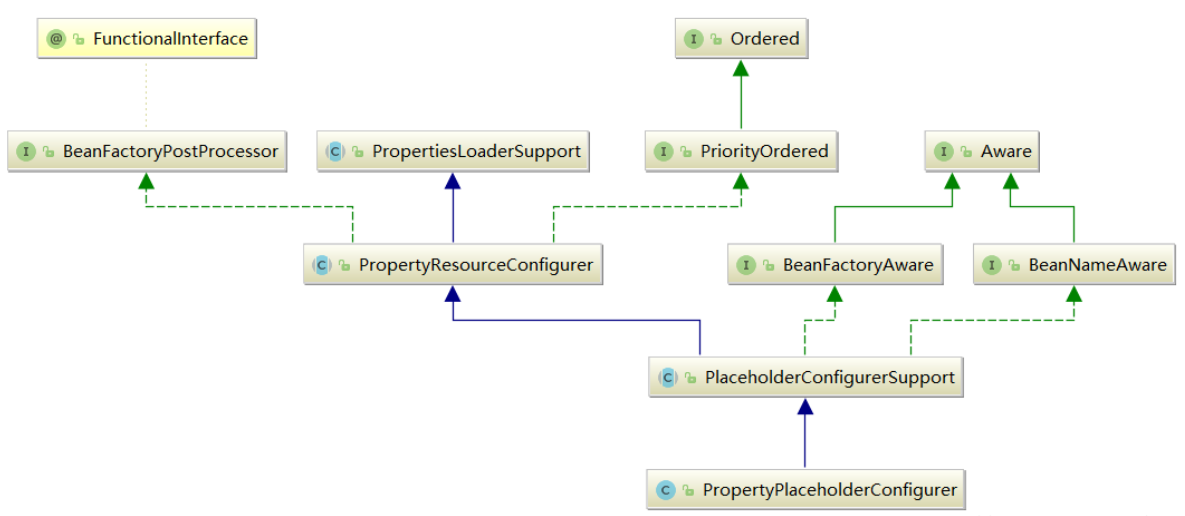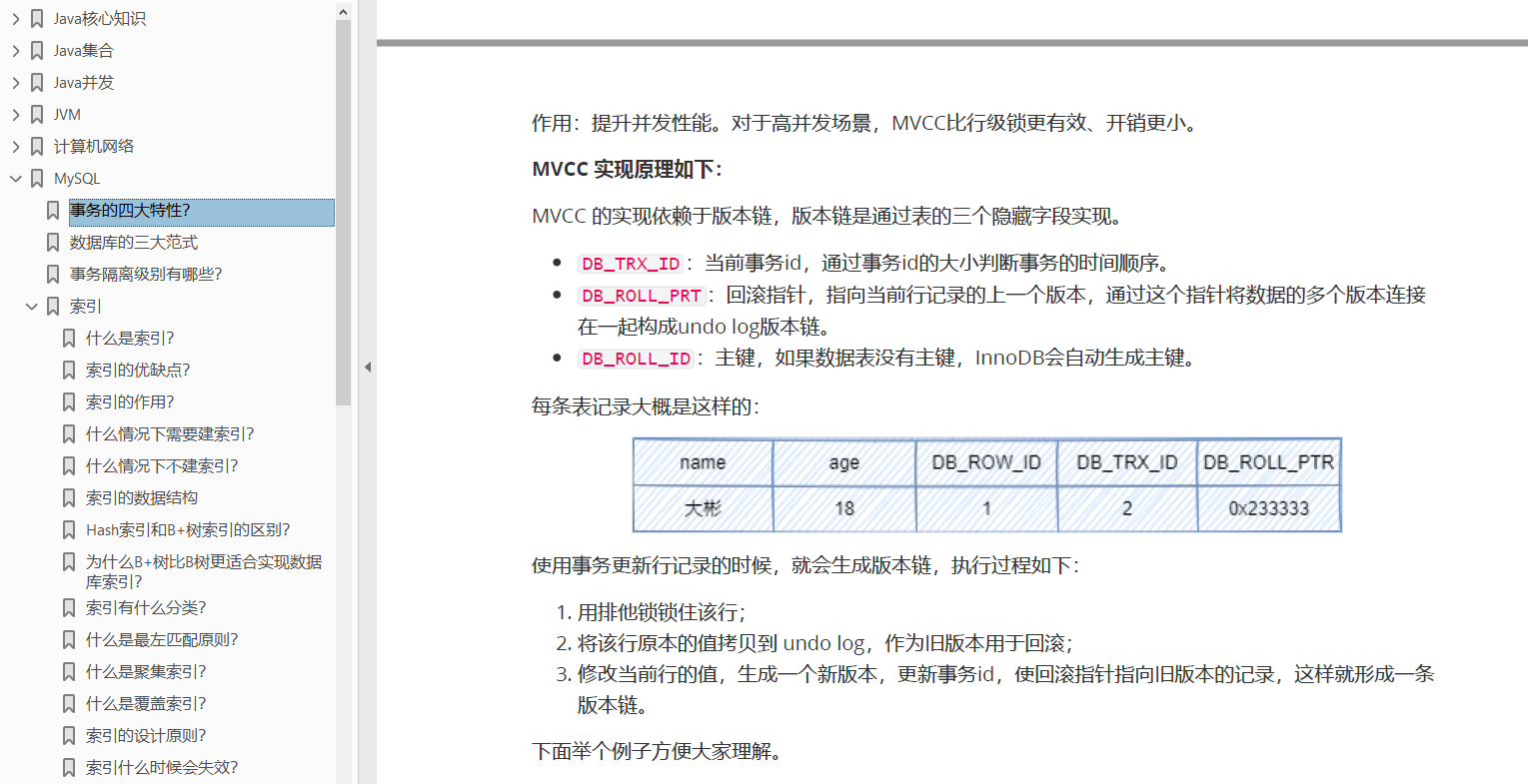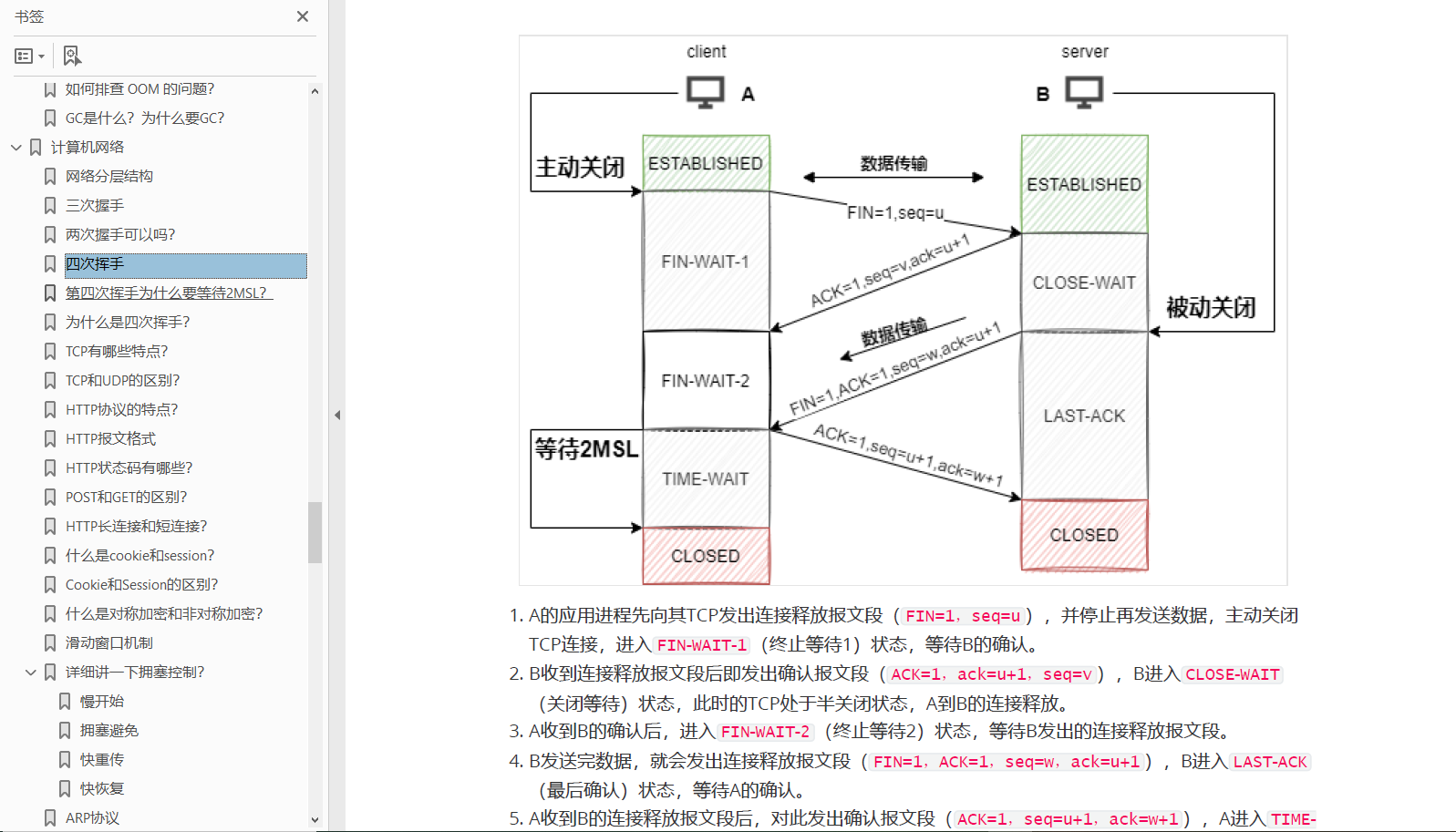Spring源码分析
正文
在之前的博文中我们一直以BeanFactory接口以及它的默认实现类XmlBeanFactory为例进行分析,但是Spring中还提供了另一个接口ApplicationContext,用于扩展BeanFactory中现有的功能。
ApplicationContext和BeanFactory两者都是用于加载Bean的,但是相比之下,ApplicationContext提供了更多的扩展功能,简而言之:ApplicationContext包含BeanFactory的所有功能。通常建议比优先使用ApplicationContext,除非在一些限制的场合,比如字节长度对内存有很大的影响时(Applet),绝大多数“典型的”企业应用系统,ApplicationContext就是需要使用的。
那么究竟ApplicationContext比BeanFactory多了哪些功能?首先我们来看看使用两个不同的类去加载配置文件在写法上的不同如下代码:
//使用BeanFactory方式加载XML.
BeanFactory bf = new XmlBeanFactory(new ClassPathResource("beanFactoryTest.xml"));
//使用ApplicationContext方式加载XML.
ApplicationContext bf = new ClassPathXmlApplicationContext("beanFactoryTest.xml");
接下来我们就以ClassPathXmlApplicationContext作为切入点,开始对整体功能进行分析。首先看下其构造函数:
public ClassPathXmlApplicationContext() {
}
public ClassPathXmlApplicationContext(ApplicationContext parent) {
super(parent);
}
public ClassPathXmlApplicationContext(String configLocation) throws BeansException {
this(new String[] {configLocation}, true, null);
}
public ClassPathXmlApplicationContext(String... configLocations) throws BeansException {
this(configLocations, true, null);
}
public ClassPathXmlApplicationContext(String[] configLocations, @Nullable ApplicationContext parent)
throws BeansException {
this(configLocations, true, parent);
}
public ClassPathXmlApplicationContext(String[] configLocations, boolean refresh) throws BeansException {
this(configLocations, refresh, null);
}
public ClassPathXmlApplicationContext(String[] configLocations, boolean refresh, @Nullable ApplicationContext parent)
throws BeansException {
super(parent);
setConfigLocations(configLocations);
if (refresh) {
refresh();
}
}
设置路径是必不可少的步骤,ClassPathXmlApplicationContext中可以将配置文件路径以数组的方式传入,ClassPathXmlApplicationContext可以对数组进行解析并进行加载。而对于解析及功能实现都在refresh()中实现。
设置配置路径
在ClassPathXmlApplicationContext中支持多个配置文件以数组方式同时传入,以下是设置配置路径方法代码:
public void setConfigLocations(@Nullable String... locations) {
if (locations != null) {
Assert.noNullElements(locations, "Config locations must not be null");
this.configLocations = new String[locations.length];
for (int i = 0; i < locations.length; i++) {
this.configLocations[i] = resolvePath(locations[i]).trim();
}
}
else {
this.configLocations = null;
}
}
其中如果给定的路径中包含特殊符号,如${var},那么会在方法resolvePath中解析系统变量并替换
扩展功能
设置了路径之后,便可以根据路径做配置文件的解析以及各种功能的实现了。可以说refresh函数中包含了几乎ApplicationContext中提供的全部功能,而且此函数中逻辑非常清晰明了,使我们很容易分析对应的层次及逻辑,我们看下方法代码:
public void refresh() throws BeansException, IllegalStateException {
synchronized (this.startupShutdownMonitor) {
//准备刷新的上下文 环境
prepareRefresh();
//初始化BeanFactory,并进行XML文件读取
/*
* ClassPathXMLApplicationContext包含着BeanFactory所提供的一切特征,在这一步骤中将会复用
* BeanFactory中的配置文件读取解析及其他功能,这一步之后,ClassPathXmlApplicationContext
* 实际上就已经包含了BeanFactory所提供的功能,也就是可以进行Bean的提取等基础操作了。
*/
ConfigurableListableBeanFactory beanFactory = obtainFreshBeanFactory();
//对beanFactory进行各种功能填充
prepareBeanFactory(beanFactory);
try {
//子类覆盖方法做额外处理
/*
* Spring之所以强大,为世人所推崇,除了它功能上为大家提供了便利外,还有一方面是它的
* 完美架构,开放式的架构让使用它的程序员很容易根据业务需要扩展已经存在的功能。这种开放式
* 的设计在Spring中随处可见,例如在本例中就提供了一个空的函数实现postProcessBeanFactory来
* 方便程序猿在业务上做进一步扩展
*/
postProcessBeanFactory(beanFactory);
//激活各种beanFactory处理器
invokeBeanFactoryPostProcessors(beanFactory);
//注册拦截Bean创建的Bean处理器,这里只是注册,真正的调用实在getBean时候
registerBeanPostProcessors(beanFactory);
//为上下文初始化Message源,即不同语言的消息体,国际化处理
initMessageSource();
//初始化应用消息广播器,并放入“applicationEventMulticaster”bean中
initApplicationEventMulticaster();
//留给子类来初始化其它的Bean
onRefresh();
//在所有注册的bean中查找Listener bean,注册到消息广播器中
registerListeners();
//初始化剩下的单实例(非惰性的)
finishBeanFactoryInitialization(beanFactory);
//完成刷新过程,通知生命周期处理器lifecycleProcessor刷新过程,同时发出ContextRefreshEvent通知别人
finishRefresh();
}
catch (BeansException ex) {
if (logger.isWarnEnabled()) {
logger.warn("Exception encountered during context initialization - " +
"cancelling refresh attempt: " + ex);
}
destroyBeans();
cancelRefresh(ex);
throw ex;
}
finally {
resetCommonCaches();
}
}
}
我们简单的分析下代码的步骤:
(1)初始化前的准备工作,例如对系统属性或者环境变量进行准备及验证。
在某种情况下项目的使用需要读取某些系统变量,而这个变量的设置很可能会影响着系统的正确性,那么ClassPathXmlApplicationContext为我们提供的这个准备函数就显得非常必要,他可以在spring启动的时候提前对必须的环境变量进行存在性验证。
(2)初始化BeanFactory,并进行XML文件读取。
之前提到ClassPathXmlApplicationContext包含着对BeanFactory所提供的一切特征,那么这一步中将会复用BeanFactory中的配置文件读取解析其他功能,这一步之后ClassPathXmlApplicationContext实际上就已经包含了BeanFactory所提供的功能,也就是可以进行Bean的提取等基本操作了。
(3)对BeanFactory进行各种功能填充
@Qualifier和@Autowired应该是大家非常熟悉的注解了,那么这两个注解正是在这一步骤中增加支持的。
(4)子类覆盖方法做额外处理。
spring之所以强大,为世人所推崇,除了它功能上为大家提供了遍历外,还有一方面是它完美的架构,开放式的架构让使用它的程序员很容易根据业务需要扩展已经存在的功能。这种开放式的设计在spring中随处可见,例如本利中就提供了一个空的函数实现postProcessBeanFactory来方便程序员在业务上做进一步的扩展。
(5)激活各种BeanFactory处理器
(6)注册拦截bean创建的bean处理器,这里只是注册,真正的调用是在getBean时候
(7)为上下文初始化Message源,及对不同语言的小西天进行国际化处理
(8)初始化应用消息广播器,并放入“applicationEventMulticaster”bean中
(9)留给子类来初始化其他的bean
(10)在所有注册的bean中查找listener bean,注册到消息广播器中
(11)初始化剩下的单实例(非惰性的)
(12)完成刷新过程,通知生命周期处理器lifecycleProcessor刷新过程,同时发出ContextRefreshEvent通知别人。
接下来我们就详细的讲解每一个过程
分享一份大彬精心整理的大厂面试手册,包含计算机基础、Java基础、多线程、JVM、数据库、Redis、Spring、Mybatis、SpringMVC、SpringBoot、分布式、微服务、设计模式、架构、校招社招分享等高频面试题,非常实用,有小伙伴靠着这份手册拿过字节offer~
需要的小伙伴可以自行下载:
prepareRefresh刷新上下文的准备工作
/**
* 准备刷新上下文环境,设置它的启动日期和活动标志,以及执行任何属性源的初始化。
* Prepare this context for refreshing, setting its startup date and
* active flag as well as performing any initialization of property sources.
*/
protected void prepareRefresh() {
this.startupDate = System.currentTimeMillis();
this.closed.set(false);
this.active.set(true);
// 在上下文环境中初始化任何占位符属性源。(空的方法,留给子类覆盖)
initPropertySources();
// 验证需要的属性文件是否都已放入环境中
getEnvironment().validateRequiredProperties();
// 允许收集早期的应用程序事件,一旦有了多播器,就可以发布……
this.earlyApplicationEvents = new LinkedHashSet<>();
}
obtainFreshBeanFactory->读取xml并初始化BeanFactory
obtainFreshBeanFactory方法从字面理解是获取beanFactory.ApplicationContext是对BeanFactory的扩展,在其基础上添加了大量的基础应用,obtainFreshBeanFactory正式实现beanFactory的地方,经过这个函数后ApplicationContext就有了BeanFactory的全部功能。我们看下此方法的代码:
protected ConfigurableListableBeanFactory obtainFreshBeanFactory() {
//初始化BeanFactory,并进行XML文件读取,并将得到的BeanFactory记录在当前实体的属性中
refreshBeanFactory();
//返回当前实体的beanFactory属性
ConfigurableListableBeanFactory beanFactory = getBeanFactory();
if (logger.isDebugEnabled()) {
logger.debug("Bean factory for " + getDisplayName() + ": " + beanFactory);
}
return beanFactory;
}
继续深入到refreshBeanFactory方法中,方法的实现是在AbstractRefreshableApplicationContext中:
@Override
protected final void refreshBeanFactory() throws BeansException {
if (hasBeanFactory()) {
destroyBeans();
closeBeanFactory();
}
try {
//创建DefaultListableBeanFactory
/*
* 以前我们分析BeanFactory的时候,不知道是否还有印象,声明方式为:BeanFactory bf =
* new XmlBeanFactory("beanFactoryTest.xml"),其中的XmlBeanFactory继承自DefaulltListableBeanFactory;
* 并提供了XmlBeanDefinitionReader类型的reader属性,也就是说DefaultListableBeanFactory是容器的基础。必须
* 首先要实例化。
*/
DefaultListableBeanFactory beanFactory = createBeanFactory();
//为了序列化指定id,如果需要的话,让这个BeanFactory从id反序列化到BeanFactory对象
beanFactory.setSerializationId(getId());
//定制beanFactory,设置相关属性,包括是否允许覆盖同名称的不同定义的对象以及循环依赖以及设置
//@Autowired和Qualifier注解解析器QualifierAnnotationAutowireCandidateResolver
customizeBeanFactory(beanFactory);
//加载BeanDefiniton
loadBeanDefinitions(beanFactory);
synchronized (this.beanFactoryMonitor) {
//使用全局变量记录BeanFactory实例。
//因为DefaultListableBeanFactory类型的变量beanFactory是函数内部的局部变量,
//所以要使用全局变量记录解析结果
this.beanFactory = beanFactory;
}
}
catch (IOException ex) {
throw new ApplicationContextException("I/O error parsing bean definition source for " + getDisplayName(), ex);
}
}
加载BeanDefinition
在第一步中提到了将ClassPathXmlApplicationContext与XMLBeanFactory创建的对比,除了初始化DefaultListableBeanFactory外,还需要XmlBeanDefinitionReader来读取XML,那么在loadBeanDefinitions方法中首先要做的就是初始化XmlBeanDefinitonReader,我们跟着到loadBeanDefinitions(beanFactory)方法体中,我们看到的是在AbstractXmlApplicationContext中实现的,具体代码如下:
@Override
protected void loadBeanDefinitions(DefaultListableBeanFactory beanFactory) throws BeansException, IOException {
// Create a new XmlBeanDefinitionReader for the given BeanFactory.
XmlBeanDefinitionReader beanDefinitionReader = new XmlBeanDefinitionReader(beanFactory);
// Configure the bean definition reader with this context's
// resource loading environment.
beanDefinitionReader.setEnvironment(this.getEnvironment());
beanDefinitionReader.setResourceLoader(this);
beanDefinitionReader.setEntityResolver(new ResourceEntityResolver(this));
// Allow a subclass to provide custom initialization of the reader,
// then proceed with actually loading the bean definitions.
initBeanDefinitionReader(beanDefinitionReader);
loadBeanDefinitions(beanDefinitionReader);
}
在初始化了DefaultListableBeanFactory和XmlBeanDefinitionReader后,就可以进行配置文件的读取了。继续进入到loadBeanDefinitions(beanDefinitionReader)方法体中,代码如下:
protected void loadBeanDefinitions(XmlBeanDefinitionReader reader) throws BeansException, IOException {
Resource[] configResources = getConfigResources();
if (configResources != null) {
reader.loadBeanDefinitions(configResources);
}
String[] configLocations = getConfigLocations();
if (configLocations != null) {
reader.loadBeanDefinitions(configLocations);
}
}
因为在XmlBeanDefinitionReader中已经将之前初始化的DefaultListableBeanFactory注册进去了,所以XmlBeanDefinitionReader所读取的BeanDefinitionHolder都会注册到DefinitionListableBeanFactory中,也就是经过这个步骤,DefaultListableBeanFactory的变量beanFactory已经包含了所有解析好的配置。
功能扩展
如上图所示prepareBeanFactory(beanFactory)就是在功能上扩展的方法,而在进入这个方法前spring已经完成了对配置的解析,接下来我们详细分析下次函数,进入方法体:
protected void prepareBeanFactory(ConfigurableListableBeanFactory beanFactory) {
// Tell the internal bean factory to use the context's class loader etc.
//设置beanFactory的classLoader为当前context的classloader
beanFactory.setBeanClassLoader(getClassLoader());
//设置beanFactory的表达式语言处理器,Spring3增加了表达式语言的支持,
//默认可以使用#{bean.xxx}的形式来调用相关属性值
beanFactory.setBeanExpressionResolver(new StandardBeanExpressionResolver(beanFactory.getBeanClassLoader()));
//为beanFactory增加了一个的propertyEditor,这个主要是对bean的属性等设置管理的一个工具
beanFactory.addPropertyEditorRegistrar(new ResourceEditorRegistrar(this, getEnvironment()));
// Configure the bean factory with context callbacks.
beanFactory.addBeanPostProcessor(new ApplicationContextAwareProcessor(this));
//设置了几个忽略自动装配的接口
beanFactory.ignoreDependencyInterface(EnvironmentAware.class);
beanFactory.ignoreDependencyInterface(EmbeddedValueResolverAware.class);
beanFactory.ignoreDependencyInterface(ResourceLoaderAware.class);
beanFactory.ignoreDependencyInterface(ApplicationEventPublisherAware.class);
beanFactory.ignoreDependencyInterface(MessageSourceAware.class);
beanFactory.ignoreDependencyInterface(ApplicationContextAware.class);
// BeanFactory interface not registered as resolvable type in a plain factory.
// MessageSource registered (and found for autowiring) as a bean.
//设置了几个自动装配的特殊规则
beanFactory.registerResolvableDependency(BeanFactory.class, beanFactory);
beanFactory.registerResolvableDependency(ResourceLoader.class, this);
beanFactory.registerResolvableDependency(ApplicationEventPublisher.class, this);
beanFactory.registerResolvableDependency(ApplicationContext.class, this);
// Register early post-processor for detecting inner beans as ApplicationListeners.
beanFactory.addBeanPostProcessor(new ApplicationListenerDetector(this));
// Detect a LoadTimeWeaver and prepare for weaving, if found.
//增加对AspectJ的支持
if (beanFactory.containsBean(LOAD_TIME_WEAVER_BEAN_NAME)) {
beanFactory.addBeanPostProcessor(new LoadTimeWeaverAwareProcessor(beanFactory));
// Set a temporary ClassLoader for type matching.
beanFactory.setTempClassLoader(new ContextTypeMatchClassLoader(beanFactory.getBeanClassLoader()));
}
// Register default environment beans.
//添加默认的系统环境bean
if (!beanFactory.containsLocalBean(ENVIRONMENT_BEAN_NAME)) {
beanFactory.registerSingleton(ENVIRONMENT_BEAN_NAME, getEnvironment());
}
if (!beanFactory.containsLocalBean(SYSTEM_PROPERTIES_BEAN_NAME)) {
beanFactory.registerSingleton(SYSTEM_PROPERTIES_BEAN_NAME, getEnvironment().getSystemProperties());
}
if (!beanFactory.containsLocalBean(SYSTEM_ENVIRONMENT_BEAN_NAME)) {
beanFactory.registerSingleton(SYSTEM_ENVIRONMENT_BEAN_NAME, getEnvironment().getSystemEnvironment());
}
}
详细分析下代码发现上面函数主要是在以下方法进行了扩展:
(1)对SPEL语言的支持
(2)增加对属性编辑器的支持
(3)增加对一些内置类的支持,如EnvironmentAware、MessageSourceAware的注入
(4)设置了依赖功能可忽略的接口
(5)注册一些固定依赖的属性
(6)增加了AspectJ的支持
(7)将相关环境变量及属性以单例模式注册
增加对SPEL语言的支持
Spring表达式语言全称为“Spring Expression Language”,缩写为“SpEL”,类似于Struts 2x中使用的OGNL语言,SpEL是单独模块,只依赖于core模块,不依赖于其他模块,可以单独使用
SpEL使用#{…}作为定界符,所有在大框号中的字符都将被认为是SpEL,使用格式如下:
<util:properties id="database" location="classpath:db.properties">
</util:properties>
<bean id="dbcp" class="org.apache.commons.dbcp.BasicDataSource">
<property name="username" value="#{database.user}"></property>
<property name="password" value="#{database.pwd}"></property>
<property name="driverClassName" value="#{database.driver}"></property>
<property name="url" value="#{database.url}"></property>
</bean>
上面只是列举了其中最简单的使用方式,SpEL功能非常强大,使用好可以大大提高开发效率。在源码中通过代码beanFactory.setBeanExpressionResolver(new StandardBeanExpressionResolver()),注册语言解析器,就可以对SpEL进行解析了,那么之后是在什么地方调用这个解析器的呢?
之前说beanFactory中说过Spring在bean进行初始化的时候会有属性填充的一步,而在这一步中Spring会调用AbstractAutowireCapabelBeanFactory类的applyPropertyValues来进行属性值得解析。同时这个步骤中一般通过AbstractBeanFactory中的evaluateBeanDefinitionString方法进行SpEL解析,方法代码如下:
protected Object evaluateBeanDefinitionString(String value, BeanDefinition beanDefinition) {
if (this.beanExpressionResolver == null) {
return value;
}
Scope scope = (beanDefinition != null ? getRegisteredScope(beanDefinition.getScope()) : null);
return this.beanExpressionResolver.evaluate(value, new BeanExpressionContext(this, scope));
}
BeanFactory的后处理
BeanFactory作为spring中容器功能的基础,用于存放所有已经加载的bean,为例保证程序上的高可扩展性,spring针对BeanFactory做了大量的扩展,比如我们熟悉的PostProcessor就是在这里实现的。接下来我们就深入分析下BeanFactory后处理
激活注册的BeanFactoryPostProcessor
在正是介绍BeanFactoryPostProcessor的后处理前我们先简单的了解下其用法,BeanFactoryPostProcessor接口跟BeanPostProcessor类似,都可以对bean的定义(配置元数据)进行处理,也就是说spring IoC容器允许BeanFactoryPostProcessor在容器实际实例化任何其他的bean之前读取配置元数据,并可能修改他。也可以配置多个BeanFactoryPostProcessor,可以通过order属性来控制BeanFactoryPostProcessor的执行顺序(此属性必须当BeanFactoryPostProcessor实现了Ordered的接口时才可以赊账,因此在实现BeanFactoryPostProcessor时应该考虑实现Ordered接口)
如果想改变世界的bean实例(例如从配置元数据创建的对象),那最好使用BeanPostProcessor。同样的BeanFactoryPostProcessor的作用域范围是容器级别的,它只是和你锁使用的容器有关。如果你在容器中定义了一个BeanFactoryPostProcessor,它仅仅对此容器中的bean进行后置处理。BeanFactoryPostProcessor不会对定义在另一个容器中的bean进行后置处理,即使这两个容器都在同一层次上。在spring中存在对于BeanFactoryPostProcessor的典型应用,如PropertyPlaceholderConfigurer。
BeanFactoryPostProcessor的典型应用:PropertyPlaceholderConfigurer
有时候我们在阅读spring的配置文件中的Bean的描述时,会遇到类似如下情况:
<bean id="user" class="com.dabin.myspring.demo.applicationcontext.User">
<property name="name" value="${user.name}"/>
<property name="birthday" value="${user.birthday"/>
</bean>
这其中出现了变量:user.name、user.name、{user.birthday},这是spring的分散配置,可以在另外的配置文件中为user.name、user.birthday指定值,例如在bean.properties文件中定义:
user.name = xiaoming
user.birthday = 2019-04-19
当访问名为user的bean时,其name属性就会被字符串xiaoming替换,那spring框架是怎么知道存在这样的配置文件呢,这个就是PropertyPlaceholderConfigurer,需要在配置文件中添加一下代码:
<bean id="userHandler" class="org.springframework.beans.factory.config.PropertyPlaceholderConfigurer">
<property name="locations">
<list>
<value>classpath:bean.properties</value>
</list>
</property>
</bean>
在这个bean中指定了配置文件的位置。其实还是有个问题,这个userHandler只不过是spring框架管理的一个bean,并没有被别的bean或者对象引用,spring的beanFactory是怎么知道这个需要从这个bean中获取配置信息呢?我们看下PropertyPlaceholderConfigurer这个类的层次结构,如下图:

从上图中我们可以看到PropertyPlaceholderConfigurer间接的继承了BeanFactoryPostProcessor接口,这是一个很特别的A接口,当spring加载任何实现了这个接口的bean的配置时,都会在bean工厂载入所有bean的配置之后执行postProcessBeanFactory方法。在PropertyResourceConfigurer类中实现了postProcessBeanFactory方法,在方法中先后调用了mergeProperties、convertProperties、processProperties这三个方法,分别得到配置,将得到的配置转换为合适的类型,最后将配置内容告知BeanFactory。
正是通过实现BeanFactoryPostProcessor接口,BeanFactory会在实例化任何bean之前获得配置信息,从而能够正确的解析bean描述文件中的变量引用。
public void postProcessBeanFactory(ConfigurableListableBeanFactory beanFactory) throws BeansException {
try {
Properties mergedProps = this.mergeProperties();
this.convertProperties(mergedProps);
this.processProperties(beanFactory, mergedProps);
} catch (IOException var3) {
throw new BeanInitializationException("Could not load properties", var3);
}
}
自定义BeanFactoryPostProcessor
编写实现了BeanFactoryPostProcessor接口的MyBeanFactoryPostProcessor的容器后处理器,如下代码:
public class MyBeanFactoryPostProcessor implements BeanFactoryPostProcessor {
public void postProcessBeanFactory(ConfigurableListableBeanFactory beanFactory) throws BeansException {
System.out.println("对容器进行后处理。。。。");
}
}
然后在配置文件中注册这个bean,如下:
<bean id="myPost" class="com.dabin.myspring.demo.applicationcontext.MyBeanFactoryPostProcessor"></bean>
最后编写测试代码:
public class Test {
public static void main(String[] args) {
ApplicationContext context = new ClassPathXmlApplicationContext("applicationContext.xml");
User user = (User)context.getBean("user");
System.out.println(user.getName());
}
}
激活BeanFactoryPostProcessor
在了解BeanFactoryPostProcessor的用法后我们便可以深入的研究BeanFactoryPostProcessor的调用过程了,其是在方法invokeBeanFactoryPostProcessors(beanFactory)中实现的,进入到方法内部:
public static void invokeBeanFactoryPostProcessors(ConfigurableListableBeanFactory beanFactory, List<BeanFactoryPostProcessor> beanFactoryPostProcessors) {
// Invoke BeanDefinitionRegistryPostProcessors first, if any.
// 1、首先调用BeanDefinitionRegistryPostProcessors
Set<String> processedBeans = new HashSet<>();
// beanFactory是BeanDefinitionRegistry类型
if (beanFactory instanceof BeanDefinitionRegistry) {
BeanDefinitionRegistry registry = (BeanDefinitionRegistry) beanFactory;
// 定义BeanFactoryPostProcessor
List<BeanFactoryPostProcessor> regularPostProcessors = new ArrayList<>();
// 定义BeanDefinitionRegistryPostProcessor集合
List<BeanDefinitionRegistryPostProcessor> registryProcessors = new ArrayList<>();
// 循环手动注册的beanFactoryPostProcessors
for (BeanFactoryPostProcessor postProcessor : beanFactoryPostProcessors) {
// 如果是BeanDefinitionRegistryPostProcessor的实例话,则调用其postProcessBeanDefinitionRegistry方法,对bean进行注册操作
if (postProcessor instanceof BeanDefinitionRegistryPostProcessor) {
// 如果是BeanDefinitionRegistryPostProcessor类型,则直接调用其postProcessBeanDefinitionRegistry
BeanDefinitionRegistryPostProcessor registryProcessor = (BeanDefinitionRegistryPostProcessor) postProcessor;
registryProcessor.postProcessBeanDefinitionRegistry(registry);
registryProcessors.add(registryProcessor);
}
// 否则则将其当做普通的BeanFactoryPostProcessor处理,直接加入regularPostProcessors集合,以备后续处理
else {
regularPostProcessors.add(postProcessor);
}
}
// Do not initialize FactoryBeans here: We need to leave all regular beans
// uninitialized to let the bean factory post-processors apply to them!
// Separate between BeanDefinitionRegistryPostProcessors that implement
// PriorityOrdered, Ordered, and the rest.
List<BeanDefinitionRegistryPostProcessor> currentRegistryProcessors = new ArrayList<>();
// First, invoke the BeanDefinitionRegistryPostProcessors that implement PriorityOrdered.
// 首先调用实现了PriorityOrdered(有限排序接口)的BeanDefinitionRegistryPostProcessors
String[] postProcessorNames = beanFactory.getBeanNamesForType(BeanDefinitionRegistryPostProcessor.class, true, false);
for (String ppName : postProcessorNames) {
if (beanFactory.isTypeMatch(ppName, PriorityOrdered.class)) {
currentRegistryProcessors.add(beanFactory.getBean(ppName, BeanDefinitionRegistryPostProcessor.class));
processedBeans.add(ppName);
}
}
// 排序
sortPostProcessors(currentRegistryProcessors, beanFactory);
// 加入registryProcessors集合
registryProcessors.addAll(currentRegistryProcessors);
// 调用所有实现了PriorityOrdered的的BeanDefinitionRegistryPostProcessors的postProcessBeanDefinitionRegistry方法,注册bean
invokeBeanDefinitionRegistryPostProcessors(currentRegistryProcessors, registry);
// 清空currentRegistryProcessors,以备下次使用
currentRegistryProcessors.clear();
// Next, invoke the BeanDefinitionRegistryPostProcessors that implement Ordered.
// 其次,调用实现了Ordered(普通排序接口)的BeanDefinitionRegistryPostProcessors
postProcessorNames = beanFactory.getBeanNamesForType(BeanDefinitionRegistryPostProcessor.class, true, false);
for (String ppName : postProcessorNames) {
if (!processedBeans.contains(ppName) && beanFactory.isTypeMatch(ppName, Ordered.class)) {
currentRegistryProcessors.add(beanFactory.getBean(ppName, BeanDefinitionRegistryPostProcessor.class));
processedBeans.add(ppName);
}
}
// 排序
sortPostProcessors(currentRegistryProcessors, beanFactory);
// 加入registryProcessors集合
registryProcessors.addAll(currentRegistryProcessors);
// 调用所有实现了PriorityOrdered的的BeanDefinitionRegistryPostProcessors的postProcessBeanDefinitionRegistry方法,注册bean
invokeBeanDefinitionRegistryPostProcessors(currentRegistryProcessors, registry);
// 清空currentRegistryProcessors,以备下次使用
currentRegistryProcessors.clear();
// Finally, invoke all other BeanDefinitionRegistryPostProcessors until no further ones appear.
// 最后,调用其他的BeanDefinitionRegistryPostProcessors
boolean reiterate = true;
while (reiterate) {
reiterate = false;
postProcessorNames = beanFactory.getBeanNamesForType(BeanDefinitionRegistryPostProcessor.class, true, false);
for (String ppName : postProcessorNames) {
if (!processedBeans.contains(ppName)) {
currentRegistryProcessors.add(beanFactory.getBean(ppName, BeanDefinitionRegistryPostProcessor.class));
processedBeans.add(ppName);
reiterate = true;
}
}
// 排序
sortPostProcessors(currentRegistryProcessors, beanFactory);
// 加入registryProcessors集合
registryProcessors.addAll(currentRegistryProcessors);
// 调用其他的BeanDefinitionRegistryPostProcessors的postProcessBeanDefinitionRegistry方法,注册bean
invokeBeanDefinitionRegistryPostProcessors(currentRegistryProcessors, registry);
// 清空currentRegistryProcessors,以备下次使用
currentRegistryProcessors.clear();
}
// Now, invoke the postProcessBeanFactory callback of all processors handled so far.
// 调用所有BeanDefinitionRegistryPostProcessor(包括手动注册和通过配置文件注册)
// 和BeanFactoryPostProcessor(只有手动注册)的回调函数-->postProcessBeanFactory
invokeBeanFactoryPostProcessors(registryProcessors, beanFactory);
invokeBeanFactoryPostProcessors(regularPostProcessors, beanFactory);
}
// 2、如果不是BeanDefinitionRegistry的实例,那么直接调用其回调函数即可-->postProcessBeanFactory
else {
// Invoke factory processors registered with the context instance.
invokeBeanFactoryPostProcessors(beanFactoryPostProcessors, beanFactory);
}
// Do not initialize FactoryBeans here: We need to leave all regular beans
// uninitialized to let the bean factory post-processors apply to them!
// 3、上面的代码已经处理完了所有的BeanDefinitionRegistryPostProcessors和手动注册的BeanFactoryPostProcessor
// 接下来要处理通过配置文件注册的BeanFactoryPostProcessor
// 首先获取所有的BeanFactoryPostProcessor(注意:这里获取的集合会包含BeanDefinitionRegistryPostProcessors)
String[] postProcessorNames = beanFactory.getBeanNamesForType(BeanFactoryPostProcessor.class, true, false);
// Separate between BeanFactoryPostProcessors that implement PriorityOrdered, Ordered, and the rest.
// 这里,将实现了PriorityOrdered,Ordered的处理器和其他的处理器区分开来,分别进行处理
// PriorityOrdered有序处理器
List<BeanFactoryPostProcessor> priorityOrderedPostProcessors = new ArrayList<>();
// Ordered有序处理器
List<String> orderedPostProcessorNames = new ArrayList<>();
// 无序处理器
List<String> nonOrderedPostProcessorNames = new ArrayList<>();
for (String ppName : postProcessorNames) {
// 判断processedBeans是否包含当前处理器(processedBeans中的处理器已经被处理过);如果包含,则不做任何处理
if (processedBeans.contains(ppName)) {
// skip - already processed in first phase above
}
else if (beanFactory.isTypeMatch(ppName, PriorityOrdered.class)) {
// 加入到PriorityOrdered有序处理器集合
priorityOrderedPostProcessors.add(beanFactory.getBean(ppName, BeanFactoryPostProcessor.class));
}
else if (beanFactory.isTypeMatch(ppName, Ordered.class)) {
// 加入到Ordered有序处理器集合
orderedPostProcessorNames.add(ppName);
}
else {
// 加入到无序处理器集合
nonOrderedPostProcessorNames.add(ppName);
}
}
// First, invoke the BeanFactoryPostProcessors that implement PriorityOrdered.
// 首先调用实现了PriorityOrdered接口的处理器
sortPostProcessors(priorityOrderedPostProcessors, beanFactory);
invokeBeanFactoryPostProcessors(priorityOrderedPostProcessors, beanFactory);
// Next, invoke the BeanFactoryPostProcessors that implement Ordered.
// 其次,调用实现了Ordered接口的处理器
List<BeanFactoryPostProcessor> orderedPostProcessors = new ArrayList<>();
for (String postProcessorName : orderedPostProcessorNames) {
orderedPostProcessors.add(beanFactory.getBean(postProcessorName, BeanFactoryPostProcessor.class));
}
sortPostProcessors(orderedPostProcessors, beanFactory);
invokeBeanFactoryPostProcessors(orderedPostProcessors, beanFactory);
// Finally, invoke all other BeanFactoryPostProcessors.
// 最后,调用无序处理器
List<BeanFactoryPostProcessor> nonOrderedPostProcessors = new ArrayList<>();
for (String postProcessorName : nonOrderedPostProcessorNames) {
nonOrderedPostProcessors.add(beanFactory.getBean(postProcessorName, BeanFactoryPostProcessor.class));
}
invokeBeanFactoryPostProcessors(nonOrderedPostProcessors, beanFactory);
// Clear cached merged bean definitions since the post-processors might have
// modified the original metadata, e.g. replacing placeholders in values...
// 清理元数据
beanFactory.clearMetadataCache();
}
循环遍历 BeanFactoryPostProcessor 中的 postProcessBeanFactory 方法
private static void invokeBeanFactoryPostProcessors(
Collection<? extends BeanFactoryPostProcessor> postProcessors, ConfigurableListableBeanFactory beanFactory) {
for (BeanFactoryPostProcessor postProcessor : postProcessors) {
postProcessor.postProcessBeanFactory(beanFactory);
}
}
注册BeanPostProcessor
在上文中提到了BeanFactoryPostProcessor的调用,接下来我们就探索下BeanPostProcessor。但这里并不是调用,而是注册,真正的调用其实是在bean的实例化阶段进行的,这是一个很重要的步骤,也是很多功能BeanFactory不知道的重要原因。spring中大部分功能都是通过后处理器的方式进行扩展的,这是spring框架的一个特写,但是在BeanFactory中其实并没有实现后处理器的自动注册,所以在调用的时候如果没有进行手动注册其实是不能使用的。但是ApplicationContext中却添加了自动注册功能,如自定义一个后处理器:
public class MyInstantiationAwareBeanPostProcessor implements InstantiationAwareBeanPostProcessor {
public Object postProcessBeforeInstantiation(Class<?> beanClass, String beanName) throws BeansException {
System.out.println("before");
return null;
}
}
然后在配置文件中添加bean的配置:
<bean class="com.dabin.myspring.demo.applicationcontext.MyInstantiationAwareBeanPostProcessor"/>
这样的话再使用BeanFactory的方式进行加载的bean在加载时不会有任何改变的,而在使用ApplicationContext方式获取的bean时就会打印出“before”,而这个特性就是咋registryBeanPostProcessor方法中完成的。
我们继续深入分析registryBeanPostProcessors的方法实现:
protected void registerBeanPostProcessors(ConfigurableListableBeanFactory beanFactory) {
PostProcessorRegistrationDelegate.registerBeanPostProcessors(beanFactory, this);
}
public static void registerBeanPostProcessors(
ConfigurableListableBeanFactory beanFactory, AbstractApplicationContext applicationContext) {
String[] postProcessorNames = beanFactory.getBeanNamesForType(BeanPostProcessor.class, true, false);
/*
* BeanPostProcessorChecker是一个普通的信息打印,可能会有些情况当spring的配置中的后
* 处理器还没有被注册就已经开了bean的初始化,这时就会打印出BeanPostProcessorChecker中
* 设定的信息
*/
int beanProcessorTargetCount = beanFactory.getBeanPostProcessorCount() + 1 + postProcessorNames.length;
beanFactory.addBeanPostProcessor(new BeanPostProcessorChecker(beanFactory, beanProcessorTargetCount));
//使用PriorityOrdered来保证顺序
List<BeanPostProcessor> priorityOrderedPostProcessors = new ArrayList<>();
List<BeanPostProcessor> internalPostProcessors = new ArrayList<>();
//使用Ordered来保证顺序
List<String> orderedPostProcessorNames = new ArrayList<>();
//无序BeanPostProcessor
List<String> nonOrderedPostProcessorNames = new ArrayList<>();
for (String ppName : postProcessorNames) {
if (beanFactory.isTypeMatch(ppName, PriorityOrdered.class)) {
BeanPostProcessor pp = beanFactory.getBean(ppName, BeanPostProcessor.class);
priorityOrderedPostProcessors.add(pp);
if (pp instanceof MergedBeanDefinitionPostProcessor) {
internalPostProcessors.add(pp);
}
}
else if (beanFactory.isTypeMatch(ppName, Ordered.class)) {
orderedPostProcessorNames.add(ppName);
}
else {
nonOrderedPostProcessorNames.add(ppName);
}
}
//第一步,注册所有实现了PriorityOrdered的BeanPostProcessor
sortPostProcessors(priorityOrderedPostProcessors, beanFactory);
registerBeanPostProcessors(beanFactory, priorityOrderedPostProcessors);
//注册实现了Ordered的BeanPostProcessor
List<BeanPostProcessor> orderedPostProcessors = new ArrayList<>();
for (String ppName : orderedPostProcessorNames) {
BeanPostProcessor pp = beanFactory.getBean(ppName, BeanPostProcessor.class);
orderedPostProcessors.add(pp);
if (pp instanceof MergedBeanDefinitionPostProcessor) {
internalPostProcessors.add(pp);
}
}
sortPostProcessors(orderedPostProcessors, beanFactory);
registerBeanPostProcessors(beanFactory, orderedPostProcessors);
//注册所有的无序的BeanPostProcessor
List<BeanPostProcessor> nonOrderedPostProcessors = new ArrayList<>();
for (String ppName : nonOrderedPostProcessorNames) {
BeanPostProcessor pp = beanFactory.getBean(ppName, BeanPostProcessor.class);
nonOrderedPostProcessors.add(pp);
if (pp instanceof MergedBeanDefinitionPostProcessor) {
internalPostProcessors.add(pp);
}
}
registerBeanPostProcessors(beanFactory, nonOrderedPostProcessors);
//注册所有的内部BeanFactoryProcessor
sortPostProcessors(internalPostProcessors, beanFactory);
registerBeanPostProcessors(beanFactory, internalPostProcessors);
// Re-register post-processor for detecting inner beans as ApplicationListeners,
//添加ApplicationListener探测器
beanFactory.addBeanPostProcessor(new ApplicationListenerDetector(applicationContext));
}
我们可以看到先从容器中获取所有类型为 BeanPostProcessor.class 的Bean的name数组,然后通过 BeanPostProcessor pp = beanFactory.getBean(ppName, BeanPostProcessor.class**);** 获取Bean的实例,最后通过 registerBeanPostProcessors(beanFactory, orderedPostProcessors);将获取到的BeanPostProcessor实例添加到容器的属性中,如下
private static void registerBeanPostProcessors(
ConfigurableListableBeanFactory beanFactory, List<BeanPostProcessor> postProcessors) {
for (BeanPostProcessor postProcessor : postProcessors) {
beanFactory.addBeanPostProcessor(postProcessor);
}
}
@Override
public void addBeanPostProcessor(BeanPostProcessor beanPostProcessor) {
Assert.notNull(beanPostProcessor, "BeanPostProcessor must not be null");
// Remove from old position, if any
this.beanPostProcessors.remove(beanPostProcessor);
// Track whether it is instantiation/destruction aware
if (beanPostProcessor instanceof InstantiationAwareBeanPostProcessor) {
this.hasInstantiationAwareBeanPostProcessors = true;
}
if (beanPostProcessor instanceof DestructionAwareBeanPostProcessor) {
this.hasDestructionAwareBeanPostProcessors = true;
}
// Add to end of list
this.beanPostProcessors.add(beanPostProcessor);
}
可以看到将 beanPostProcessor 实例添加到容器的 beanPostProcessors 属性中
初始化Message资源
该方法不是很重要,留在以后分析吧。
初始事件广播器
初始化ApplicationEventMulticaster是在方法initApplicationEventMulticaster()中实现的,进入到方法体,如下:
protected void initApplicationEventMulticaster() {
ConfigurableListableBeanFactory beanFactory = getBeanFactory();
// 1、默认使用内置的事件广播器,如果有的话.
// 我们可以在配置文件中配置Spring事件广播器或者自定义事件广播器
// 例如: <bean id="applicationEventMulticaster" class="org.springframework.context.event.SimpleApplicationEventMulticaster"></bean>
if (beanFactory.containsLocalBean(APPLICATION_EVENT_MULTICASTER_BEAN_NAME)) {
this.applicationEventMulticaster = beanFactory.getBean(APPLICATION_EVENT_MULTICASTER_BEAN_NAME, ApplicationEventMulticaster.class);
}
// 2、否则,新建一个事件广播器,SimpleApplicationEventMulticaster是spring的默认事件广播器
else {
this.applicationEventMulticaster = new SimpleApplicationEventMulticaster(beanFactory);
beanFactory.registerSingleton(APPLICATION_EVENT_MULTICASTER_BEAN_NAME, this.applicationEventMulticaster);
}
}
通过源码可以看到其实现逻辑与initMessageSource基本相同,其步骤如下:
(1)查找是否有name为applicationEventMulticaster的bean,如果有放到容器里,如果没有,初始化一个系统默认的SimpleApplicationEventMulticaster放入容器
(2)查找手动设置的applicationListeners,添加到applicationEventMulticaster里
(3)查找定义的类型为ApplicationListener的bean,设置到applicationEventMulticaster
(4)初始化完成、对earlyApplicationEvents里的事件进行通知(此容器仅仅是广播器未建立的时候保存通知信息,一旦容器建立完成,以后均直接通知)
(5)在系统操作时候,遇到的各种bean的通知事件进行通知
可以看到的是applicationEventMulticaster是一个标准的观察者模式,对于他内部的监听者applicationListeners,每次事件到来都会一一获取通知。
注册监听器
protected void registerListeners() {
// Register statically specified listeners first.
// 首先,注册指定的静态事件监听器,在spring boot中有应用
for (ApplicationListener<?> listener : getApplicationListeners()) {
getApplicationEventMulticaster().addApplicationListener(listener);
}
// Do not initialize FactoryBeans here: We need to leave all regular beans
// uninitialized to let post-processors apply to them!
// 其次,注册普通的事件监听器
String[] listenerBeanNames = getBeanNamesForType(ApplicationListener.class, true, false);
for (String listenerBeanName : listenerBeanNames) {
getApplicationEventMulticaster().addApplicationListenerBean(listenerBeanName);
}
// Publish early application events now that we finally have a multicaster...
// 如果有早期事件的话,在这里进行事件广播
// 因为前期SimpleApplicationEventMulticaster尚未注册,无法发布事件,
// 因此早期的事件会先存放在earlyApplicationEvents集合中,这里把它们取出来进行发布
// 所以早期事件的发布时间节点是早于其他事件的
Set<ApplicationEvent> earlyEventsToProcess = this.earlyApplicationEvents;
// 早期事件广播器是一个Set<ApplicationEvent>集合,保存了无法发布的早期事件,当SimpleApplicationEventMulticaster
// 创建完之后随即进行发布,同事也要将其保存的事件释放
this.earlyApplicationEvents = null;
if (earlyEventsToProcess != null) {
for (ApplicationEvent earlyEvent : earlyEventsToProcess) {
getApplicationEventMulticaster().multicastEvent(earlyEvent);
}
}
}
我们来看一下Spring的事件监昕的简单用法
定义监听事件
public class TestEvent extends ApplicationonEvent {
public String msg;
public TestEvent (Object source ) {
super (source );
}
public TestEvent (Object source , String msg ) {
super(source);
this.msg = msg ;
}
public void print () {
System.out.println(msg) ;
}
}
定义监昕器
public class TestListener implement ApplicationListener {
public void onApplicationEvent (ApplicationEvent event ) {
if (event instanceof TestEvent ) {
TestEvent testEvent = (TestEvent) event ;
testEvent print () ;
}
}
}
添加配置文件
<bean id=” testListener” class=” com.test.event.TestListener ” />
测试
@Test
public void MyAopTest() {
ApplicationContext ac = new ClassPathXmlApplicationContext("spring-aop.xml");
TestEvent event = new TestEvent (“hello” ,”msg”) ;
context.publishEvent(event);
}
源码分析
protected void publishEvent(Object event, ResolvableType eventType) {
Assert.notNull(event, "Event must not be null");
if (logger.isTraceEnabled()) {
logger.trace("Publishing event in " + getDisplayName() + ": " + event);
}
// Decorate event as an ApplicationEvent if necessary
ApplicationEvent applicationEvent;
//支持两种事件1、直接继承ApplicationEvent,2、其他时间,会被包装为PayloadApplicationEvent,可以使用getPayload获取真实的通知内容
if (event instanceof ApplicationEvent) {
applicationEvent = (ApplicationEvent) event;
}
else {
applicationEvent = new PayloadApplicationEvent<Object>(this, event);
if (eventType == null) {
eventType = ((PayloadApplicationEvent)applicationEvent).getResolvableType();
}
}
// Multicast right now if possible - or lazily once the multicaster is initialized
if (this.earlyApplicationEvents != null) {
//如果有预制行添加到预制行,预制行在执行一次后被置为null,以后都是直接执行
this.earlyApplicationEvents.add(applicationEvent);
}
else {
//广播event事件
getApplicationEventMulticaster().multicastEvent(applicationEvent, eventType);
}
// Publish event via parent context as well...
//父bean同样广播
if (this.parent != null) {
if (this.parent instanceof AbstractApplicationContext) {
((AbstractApplicationContext) this.parent).publishEvent(event, eventType);
}
else {
this.parent.publishEvent(event);
}
}
}
查找所有的监听者,依次遍历,如果有线程池,利用线程池进行发送,如果没有则直接发送,如果针对比较大的并发量,我们应该采用线程池模式,将发送通知和真正的业务逻辑进行分离
public void multicastEvent(final ApplicationEvent event, ResolvableType eventType) {
ResolvableType type = (eventType != null ? eventType : resolveDefaultEventType(event));
for (final ApplicationListener<?> listener : getApplicationListeners(event, type)) {
Executor executor = getTaskExecutor();
if (executor != null) {
executor.execute(new Runnable() {
@Override
public void run() {
invokeListener(listener, event);
}
});
}
else {
invokeListener(listener, event);
}
}
}
调用invokeListener
protected void invokeListener(ApplicationListener listener, ApplicationEvent event) {
ErrorHandler errorHandler = getErrorHandler();
if (errorHandler != null) {
try {
listener.onApplicationEvent(event);
}
catch (Throwable err) {
errorHandler.handleError(err);
}
}
else {
try {
listener.onApplicationEvent(event);
}
catch (ClassCastException ex) {
// Possibly a lambda-defined listener which we could not resolve the generic event type for
LogFactory.getLog(getClass()).debug("Non-matching event type for listener: " + listener, ex);
}
}
}
初始化其他的单例Bean(非延迟加载的)
protected void finishBeanFactoryInitialization(ConfigurableListableBeanFactory beanFactory) {
// Initialize conversion service for this context.
// 判断有无ConversionService(bean属性类型转换服务接口),并初始化
if (beanFactory.containsBean(CONVERSION_SERVICE_BEAN_NAME)
&& beanFactory.isTypeMatch(CONVERSION_SERVICE_BEAN_NAME, ConversionService.class)) {
beanFactory.setConversionService(beanFactory.getBean(CONVERSION_SERVICE_BEAN_NAME, ConversionService.class));
}
//
// Register a default embedded value resolver if no bean post-processor
// (such as a PropertyPlaceholderConfigurer bean) registered any before:
// at this point, primarily for resolution in annotation attribute values.
// 如果beanFactory中不包含EmbeddedValueResolver,则向其中添加一个EmbeddedValueResolver
// EmbeddedValueResolver-->解析bean中的占位符和表达式
if (!beanFactory.hasEmbeddedValueResolver()) {
beanFactory.addEmbeddedValueResolver(strVal -> getEnvironment().resolvePlaceholders(strVal));
}
// Initialize LoadTimeWeaverAware beans early to allow for registering their transformers early.
// 初始化LoadTimeWeaverAware类型的bean
// LoadTimeWeaverAware-->加载Spring Bean时织入第三方模块,如AspectJ
String[] weaverAwareNames = beanFactory.getBeanNamesForType(LoadTimeWeaverAware.class, false, false);
for (String weaverAwareName : weaverAwareNames) {
getBean(weaverAwareName);
}
// Stop using the temporary ClassLoader for type matching.
// 释放临时类加载器
beanFactory.setTempClassLoader(null);
// Allow for caching all bean definition metadata, not expecting further changes.
// 冻结缓存的BeanDefinition元数据
beanFactory.freezeConfiguration();
// Instantiate all remaining (non-lazy-init) singletons.
// 初始化其他的非延迟加载的单例bean
beanFactory.preInstantiateSingletons();
}
我们重点看 beanFactory.preInstantiateSingletons();
@Override
public void preInstantiateSingletons() throws BeansException {
if (logger.isTraceEnabled()) {
logger.trace("Pre-instantiating singletons in " + this);
}
// Iterate over a copy to allow for init methods which in turn register new bean definitions.
// While this may not be part of the regular factory bootstrap, it does otherwise work fine.
List<String> beanNames = new ArrayList<>(this.beanDefinitionNames);
// Trigger initialization of all non-lazy singleton beans...
for (String beanName : beanNames) {
RootBeanDefinition bd = getMergedLocalBeanDefinition(beanName);
if (!bd.isAbstract() && bd.isSingleton() && !bd.isLazyInit()) {
if (isFactoryBean(beanName)) {
Object bean = getBean(FACTORY_BEAN_PREFIX + beanName);
if (bean instanceof FactoryBean) {
final FactoryBean<?> factory = (FactoryBean<?>) bean;
boolean isEagerInit;
if (System.getSecurityManager() != null && factory instanceof SmartFactoryBean) {
isEagerInit = AccessController.doPrivileged((PrivilegedAction<Boolean>)
((SmartFactoryBean<?>) factory)::isEagerInit,
getAccessControlContext());
}
else {
isEagerInit = (factory instanceof SmartFactoryBean &&
((SmartFactoryBean<?>) factory).isEagerInit());
}
if (isEagerInit) {
getBean(beanName);
}
}
}
else {
getBean(beanName);
}
}
}
}
完成刷新过程,通知生命周期处理器lifecycleProcessor刷新过程,同时发出ContextRefreshEvent通知
protected void finishRefresh() {
// Clear context-level resource caches (such as ASM metadata from scanning).
// 清空资源缓存
clearResourceCaches();
// Initialize lifecycle processor for this context.
// 初始化生命周期处理器
initLifecycleProcessor();
// Propagate refresh to lifecycle processor first.
// 调用生命周期处理器的onRefresh方法
getLifecycleProcessor().onRefresh();
// Publish the final event.
// 推送容器刷新事件
publishEvent(new ContextRefreshedEvent(this));
// Participate in LiveBeansView MBean, if active.
LiveBeansView.registerApplicationContext(this);
}
分享一份大彬精心整理的大厂面试手册,包含计算机基础、Java基础、多线程、JVM、数据库、Redis、Spring、Mybatis、SpringMVC、SpringBoot、分布式、微服务、设计模式、架构、校招社招分享等高频面试题,非常实用,有小伙伴靠着这份手册拿过字节offer~


需要的小伙伴可以自行下载: